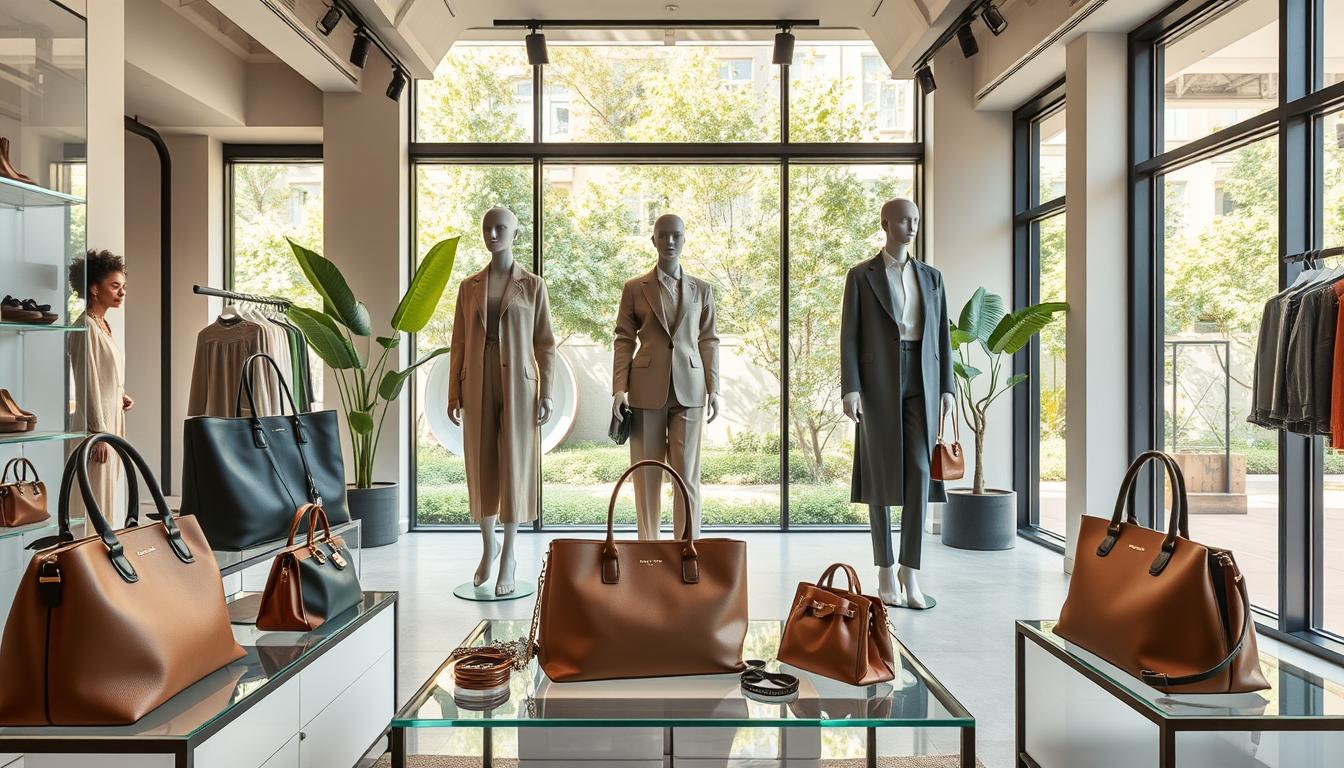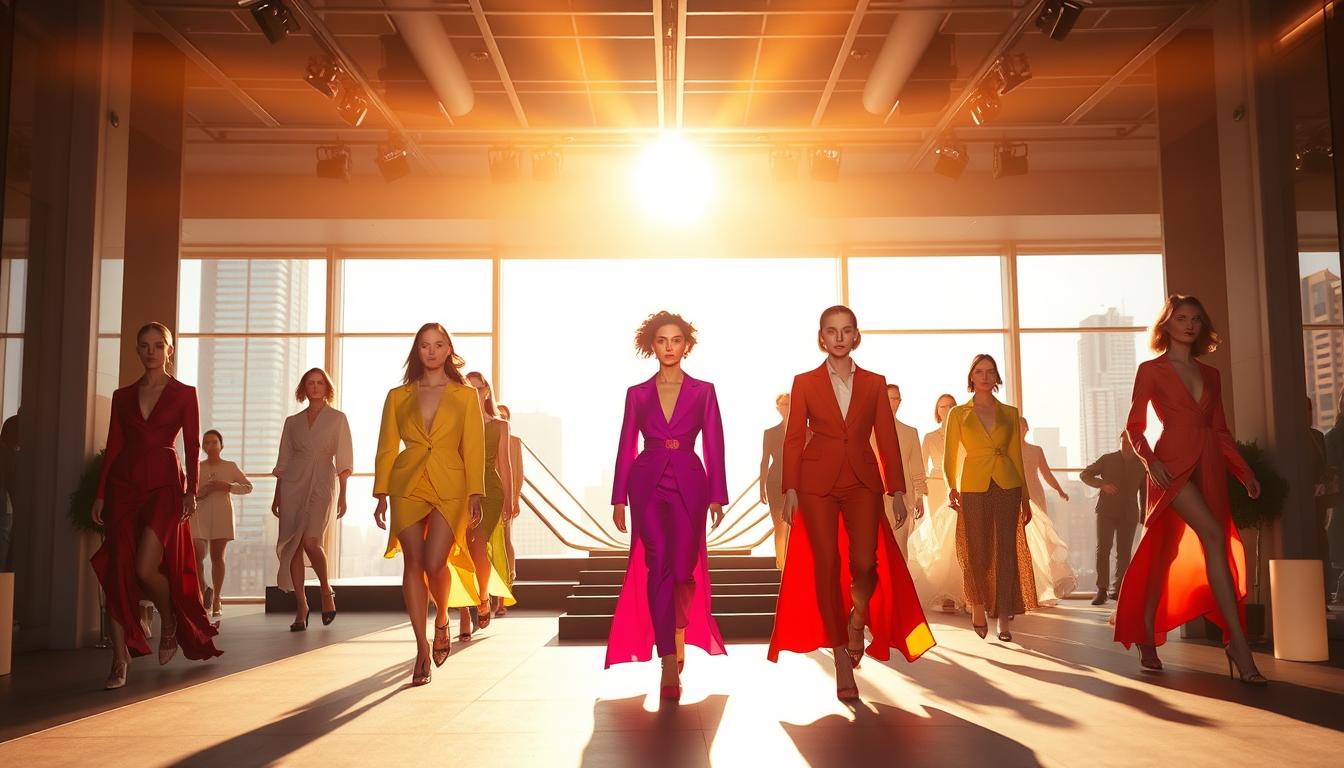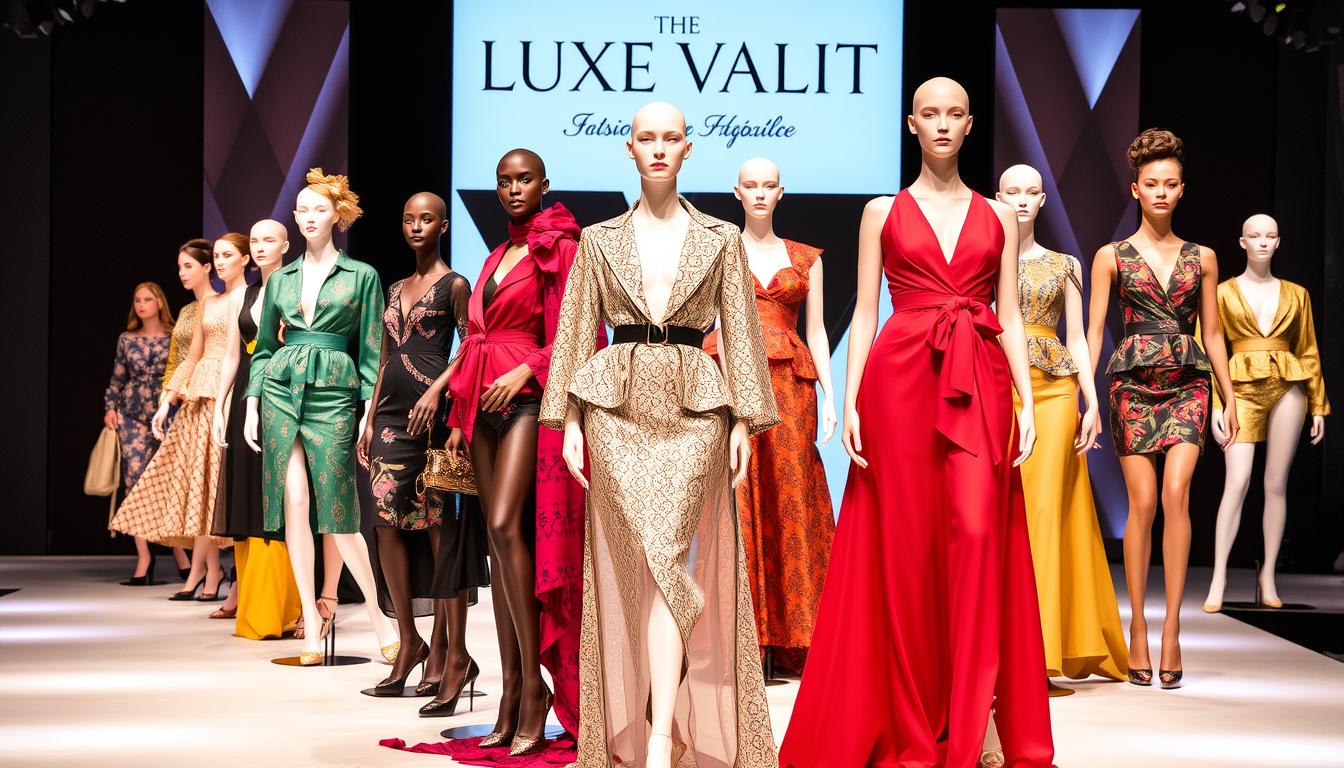The fashion industry is at a crossroads, with the climate crisis pressing brands and consumers to adopt sustainable practices. As we approach 2025, the need for environmentally responsible fashion has never been more urgent.
We’re witnessing a significant shift in the fashion world, with luxury brands reimagining their approach to prioritize environmental impact and ethical practices. This change is driven by consumers demanding more accountability and transparency from brands.
The industry is moving away from conspicuous consumption toward mindful choices, with innovative materials and circular design principles transforming the luxury fashion landscape.
Key Takeaways
- Luxury brands are prioritizing sustainability and environmental responsibility.
- Consumers are driving change by demanding accountability from brands.
- Innovative materials and circular design principles are transforming luxury fashion.
- The concept of luxury is being redefined to include ethical practices.
- Sustainable luxury is becoming the new standard in the fashion industry.
The Transformation of Luxury Fashion in 2025
In 2025, the luxury fashion landscape is being reshaped by the imperative of sustainability, forcing brands to rethink their practices and products. The fashion industry, known for its high-end aesthetics, is now prioritizing eco-friendly materials, reducing waste, and implementing ethical production methods.
The Urgent Need for Sustainable Practices
The environmental crisis has made it clear that the fashion industry must adopt more sustainable practices. Luxury brands are leading this change by embracing eco-friendly materials and reducing their environmental impact. This shift is driven by the growing awareness among consumers about the social and environmental consequences of their purchasing decisions.
As a result, luxury brands are now focusing on transparency and ethical practices throughout their supply chains. This not only helps in minimizing the negative impact on the planet but also enhances the brand’s reputation and appeal to the conscious consumer.
Redefining Luxury Through Eco-Conscious Design
Eco-conscious design is redefining the concept of luxury in the fashion industry. It’s no longer just about exclusivity and opulence; it’s about responsibility and mindful creation. Luxury brands are now incorporating eco-friendly practices into their design processes, from using recycled materials to designing products for recyclability or biodegradation.
This transformation is not limited to materials; it encompasses the entire lifecycle of fashion items. By adopting a holistic approach to sustainability, luxury brands are not only reducing their environmental footprint but also creating a new landscape for the industry, one that values both aesthetic beauty and environmental stewardship.
Designer Clothing & Accessories in 2025: Top Trends, Sustainable Luxury
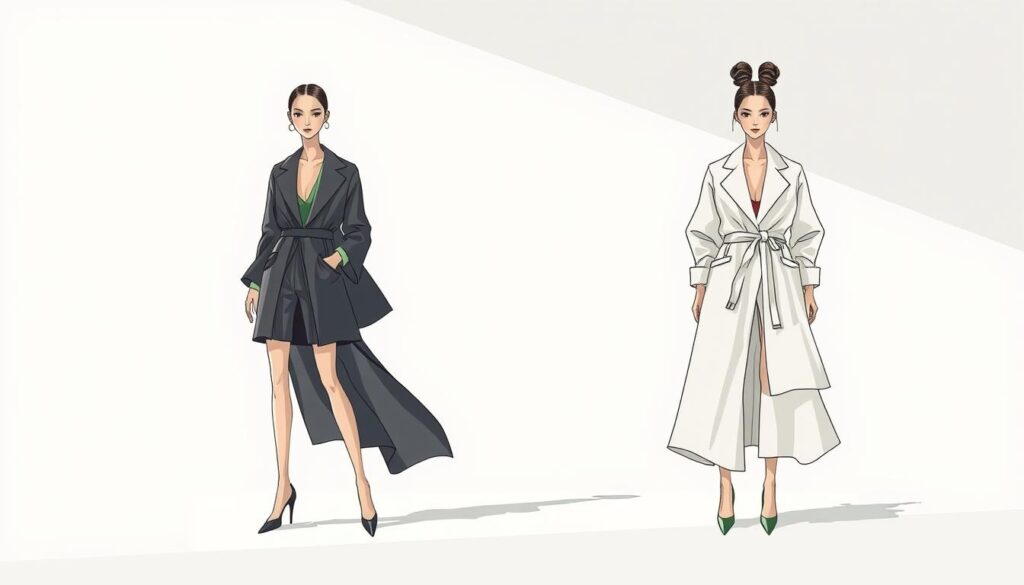
In 2025, the fusion of style and sustainability is giving rise to a new era of luxury fashion, characterized by timeless designs and environmentally responsible practices. As consumers become increasingly conscious of the environmental and social impact of their purchasing decisions, brands are responding by adopting sustainable materials and production methods.
Transparency in Production and Supply Chains
One of the key trends in sustainable luxury fashion is transparency in production and supply chains. Consumers are demanding more visibility into how their garments are made, and brands are using technologies like blockchain to provide this information. This not only ensures the authenticity of luxury goods but also verifies their ethical credentials.
By embracing transparency, luxury fashion brands can build trust with their consumers and demonstrate their commitment to sustainability. This shift towards openness is revolutionizing the industry, making it more accountable and responsible.
Mindful Consumption and Investment Pieces
Another significant trend is the shift towards mindful consumption, with luxury consumers investing in fewer, higher-quality pieces that are designed to last. These investment pieces are not just financially valuable but also carry environmental and social value, as consumers consider the full lifecycle impact of their fashion choices.
Designer brands are responding by creating timeless collections that transcend seasonal trends, focusing on exceptional craftsmanship and sustainable materials that age beautifully. This approach not only reduces waste but also encourages a more thoughtful and considered approach to clothing and garments.
Revolutionary Sustainable Materials Reshaping Designer Fashion
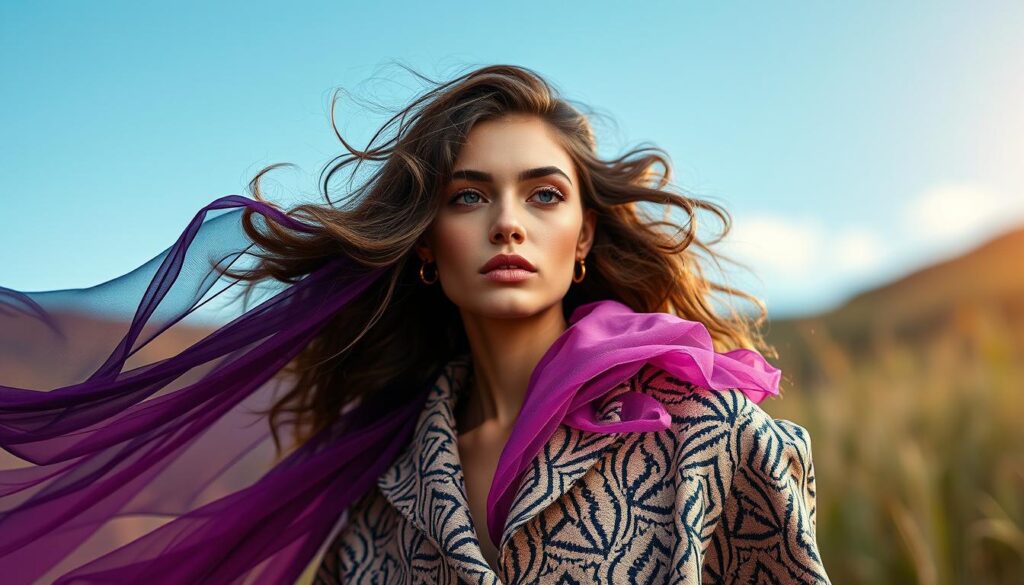
We’re witnessing a significant shift in designer fashion, with revolutionary sustainable materials becoming the new standard for luxury brands. The fashion industry is embracing eco-friendly alternatives that not only reduce environmental impact but also offer unique aesthetic qualities and enhanced performance.
Plant-Based and Vegan Luxury Textiles
Plant-based and vegan luxury textiles are gaining prominence in the fashion industry. Innovations like grape-based leather, mushroom textiles (Mylo™), and algae-derived fabrics are transforming what’s possible in luxury fashion without animal products. These materials are not only sustainable but also offer premium quality and unique properties.
Recycled and Upcycled Premium Fabrics
Recycled and upcycled fabrics have evolved beyond their former associations with lower quality. Advanced processing techniques are now transforming these materials into premium fabrics that are sought after for their sustainability and unique characteristics. Brands are incorporating recycled cashmere, organic cotton, and recycled polyester into their collections.
Regenerative Agriculture in Fashion
Regenerative agriculture is creating a new standard for natural fibers like cotton and wool. Luxury brands are investing in farming practices that improve soil health and biodiversity. This approach not only reduces the environmental impact of production but also enhances the quality and durability of the materials.
These revolutionary materials are not just environmentally superior; they often offer enhanced performance, durability, and unique aesthetic qualities that conventional materials cannot match. As the fashion industry continues to evolve, the adoption of sustainable materials will play a crucial role in shaping the future of luxury fashion.
Circular Fashion: The New Paradigm for Luxury Brands
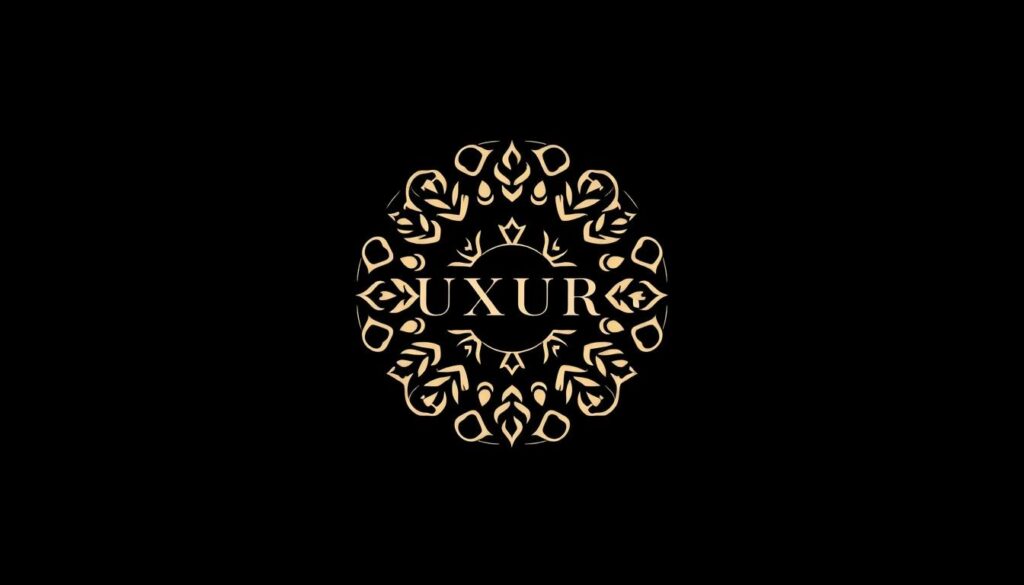
In 2025, luxury brands are embracing circular fashion as a new paradigm to reduce waste and enhance sustainability. We’re seeing a significant shift in how garments are designed, produced, used, and eventually recycled. This transformation is driven by the need to minimize environmental impact while creating new revenue streams and customer engagement opportunities.
Zero-Waste Design Approaches
We’re witnessing a revolution in design approaches with the adoption of zero-waste techniques. Patterns are being optimized to utilize 100% of fabric, eliminating cutting waste. Additionally, 3D knitting and weaving technologies are enabling the production of seamless garments that require no cutting and generate no waste, while offering superior fit and comfort.
For instance, brands like Eileen Fisher are pioneering this approach through their Waste No More initiative, transforming unsellable items and fabric scraps into new creations. This not only reduces waste but also adds value to the production process.
Take-Back Programs and Closed-Loop Systems
The proliferation of sophisticated take-back programs has become standard practice among luxury brands. These programs allow customers to return items at the end of their useful life, facilitating closed-loop systems where materials are continuously recycled without quality degradation. This creates a perpetual cycle that eliminates the concept of waste.
Eileen Fisher’s Renew program is a prime example, having rescued over 1.9 million garments for resale, donation, or repurposing. Such initiatives not only reduce environmental impact but also foster customer loyalty and engagement.
As we move forward, it’s clear that circular fashion is not just a trend but a fundamental shift in the luxury fashion industry. By adopting zero-waste design approaches and implementing take-back programs, luxury brands can significantly reduce their environmental footprint while enhancing their brand value.
Digital Fashion Revolution in Luxury Markets

In 2025, the luxury fashion landscape is being reshaped by the digital revolution, bringing forth unprecedented opportunities for creativity and sustainability. The fashion industry is embracing this change, with digital fashion emerging as a significant trend.
NFTs and Digital-Only Designer Collections
The rise of NFTs (non-fungible tokens) has created a new category of collectible digital fashion, allowing luxury brands to release limited-edition collections that can be owned, traded, and displayed in virtual environments. These digital-only designer collections are pushing creative boundaries beyond what’s physically possible.
Virtual Wardrobes and Digital Fashion Experiences
Virtual wardrobes are becoming increasingly sophisticated, allowing consumers to “try on” digital versions of physical garments before purchasing. This not only enhances the shopping experience but also reduces return rates and the associated carbon footprint, having a positive impact on sustainability. Augmented reality (AR) and virtual reality (VR) are creating immersive digital fashion experiences, from virtual fashion shows to interactive shopping environments.
The integration of wardrobes with digital platforms is revolutionizing how luxury fashion is experienced and consumed. As the brand identity evolves, it is crucial to maintain a balance between physical and digital presence.
Ethical Production Transforming Luxury Supply Chains
As we step into 2025, the luxury fashion industry is witnessing a paradigm shift towards ethical production. This transformation is driven by consumer demand for greater transparency and accountability in the supply chains of luxury brands. Ethical production is becoming the cornerstone of luxury fashion, with brands reimagining their supply chains to prioritize human welfare alongside environmental concerns.
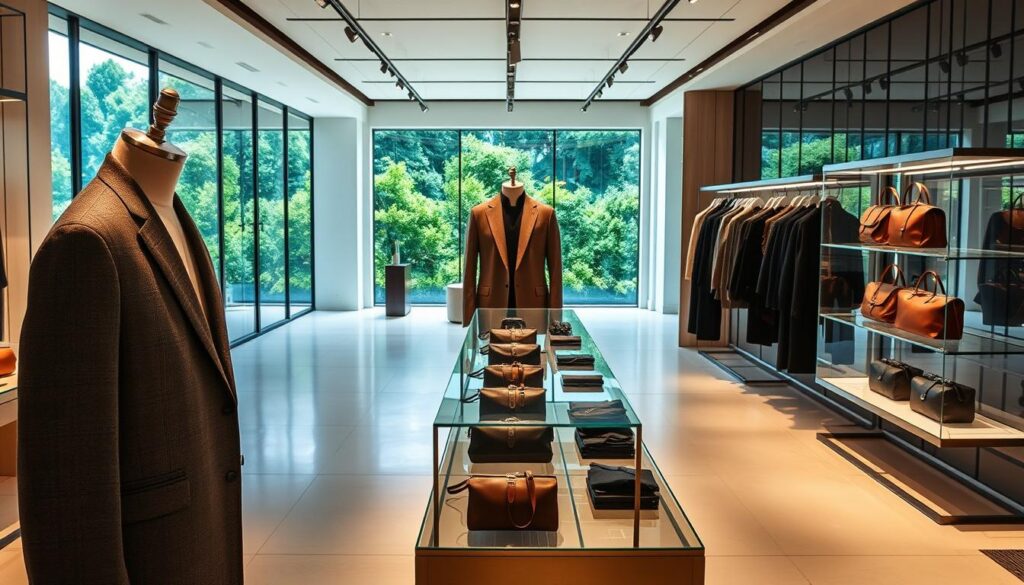
One of the key technologies driving this change is blockchain, which is revolutionizing traceability in designer fashion. By creating tamper-proof digital records, blockchain technology tracks each garment from raw material to finished product, empowering consumers to make informed choices.
Blockchain Traceability in Designer Fashion
Blockchain traceability is providing unprecedented transparency in the luxury fashion industry. Brands like Stella McCartney are leveraging blockchain platforms to ensure adherence to certifications and safety standards. This technology allows consumers to access detailed information about a garment’s journey through simple QR codes or NFC tags, fostering a deeper connection between consumers and their clothing.
“The use of blockchain in fashion is not just about transparency; it’s about creating a more sustainable and equitable industry.”
Fair Labor Practices in High-End Ateliers
Fair labor practices have become non-negotiable in high-end ateliers, with luxury brands investing in worker welfare, fair compensation, and safe working conditions throughout their supply chains. This shift is not only improving the lives of workers but also preserving and celebrating artisanal craftsmanship. Luxury brands are creating programs to train new generations in traditional techniques while providing sustainable livelihoods.
By prioritizing ethical production, luxury brands are creating a more sustainable and responsible fashion industry. This transformation is having a positive impact on both the environment and society, setting a new standard for the future of fashion.
Gender Fluidity Breaking Traditional Norms in Luxury Fashion
Gender fluidity is redefining the landscape of luxury fashion, breaking down traditional norms and creating a more inclusive style environment. As we move into 2025, the fashion industry is witnessing a significant shift towards genderless collections and designs that cater to a broader audience.
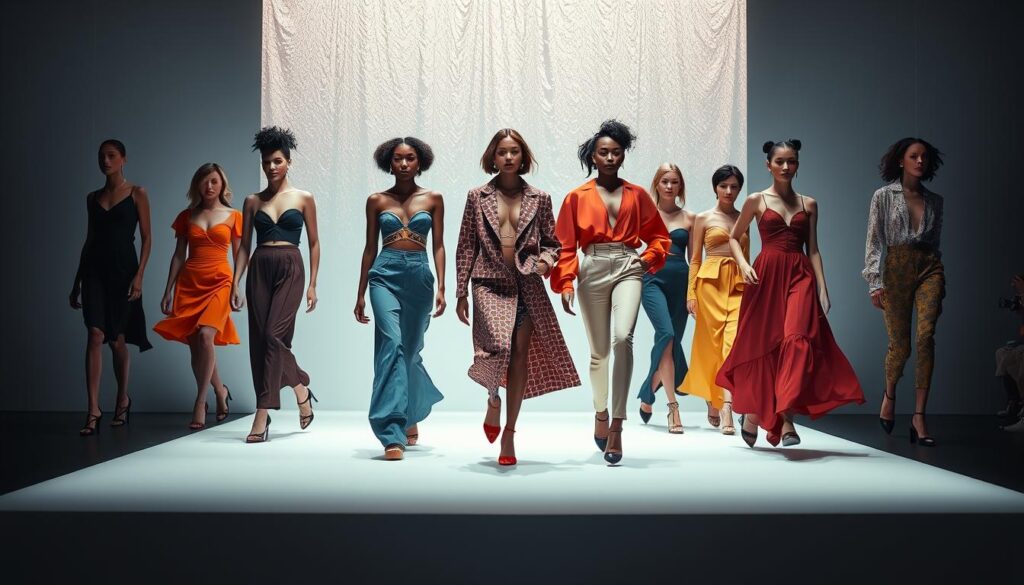
Prestigious Houses Embracing Genderless Collections
Prestigious fashion houses are at the forefront of this movement, abandoning rigid gender categories in favor of garments that focus on design integrity rather than gender specificity. This shift is liberating designs from conventional constraints, resulting in innovative silhouettes and fresh perspectives on proportion and form. By doing so, these brands are not only promoting inclusivity but also driving creative innovation in the world of luxury fashion.
Inclusive Sizing and Adaptive Luxury Design
The trend towards inclusivity is also reflected in the adoption of inclusive sizing practices among luxury brands. By extending their size ranges, these companies are making high-end fashion accessible to diverse body types without compromising on quality or design. Furthermore, adaptive luxury design is making pieces accessible to people with disabilities, integrating thoughtful features into beautiful garments. This movement is not just socially progressive; it’s also opening new markets for forward-thinking luxury fashion companies in the global world.
As this trend continues to gain momentum, we can expect to see even more innovative and inclusive designs in the luxury fashion sector, redefining the industry’s approach to style and accessibility.
AI and Technology Revolutionizing Sustainable Luxury Design
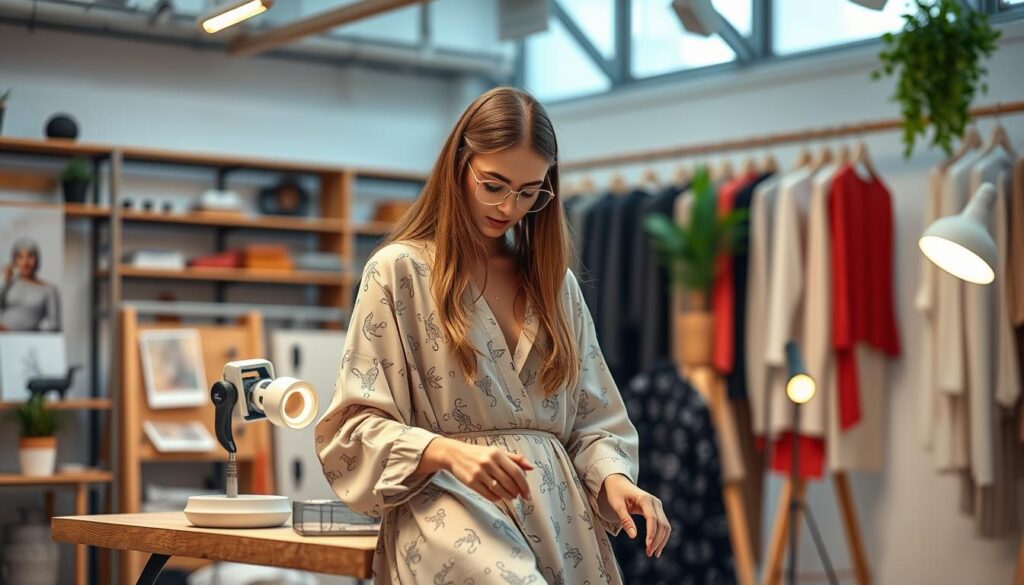
As we step into 2025, AI is revolutionizing the world of luxury fashion. The integration of artificial intelligence in design processes is not just a trend; it’s a transformative force reshaping the industry. We’re witnessing a significant shift towards sustainable fashion, driven by technological innovations that minimize environmental impact while maximizing creativity.
AI-Generated Patterns and Waste Reduction
AI-generated patterns are at the forefront of this revolution, enabling designers to create complex designs that optimize material usage and significantly reduce waste. By leveraging algorithms, luxury brands can now produce designs that were previously impossible to conceive manually, thereby enhancing their sustainable fashion credentials.
Smart Textiles and Wearable Luxury Technology
The emergence of technology-infused textiles is another exciting development. Smart textiles can change color, adapt to temperature, or monitor health metrics, all while maintaining the luxurious feel and appearance expected from high-end fashion. This integration of technology into luxury accessories is creating a new paradigm in wearable luxury, where functionality meets high-end design.
By embracing AI and advanced technology, the fashion industry is not only reducing its environmental footprint but also redefining the concept of luxury. As brands continue to innovate and adopt sustainable practices in their production processes, we’re likely to see a more responsible and creative fashion industry emerge.
Leading Sustainable Luxury Brands of 2025
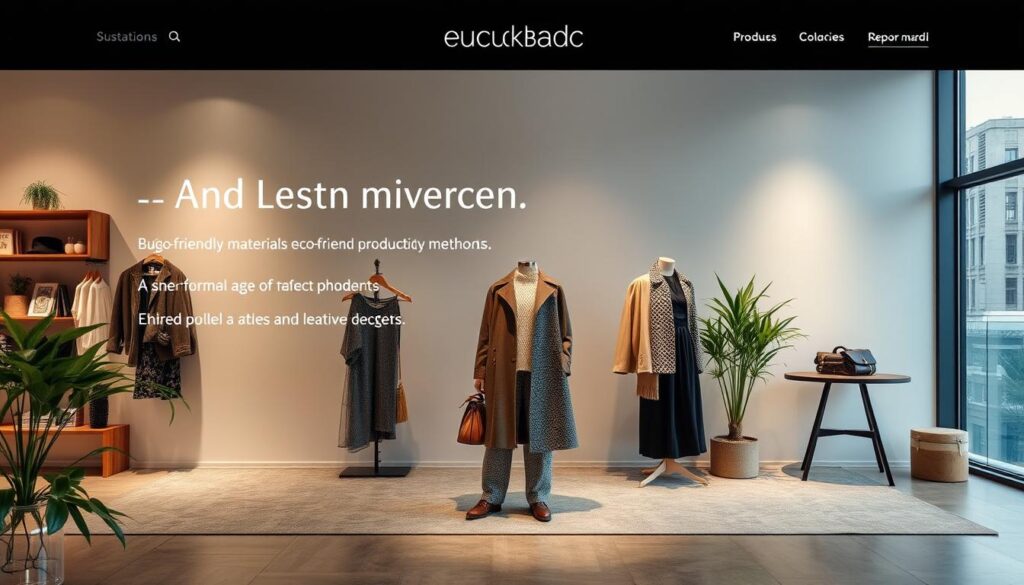
The luxury fashion industry in 2025 is characterized by a new hierarchy, where sustainability credentials are as crucial as heritage and craftsmanship. We’re seeing a significant shift towards eco-friendly materials, practices, and brand transparency.
Pioneers Like Stella McCartney and Gabriela Hearst
Brands like Stella McCartney and Gabriela Hearst have been at the forefront of sustainable luxury fashion. Stella McCartney has championed innovative, eco-friendly materials such as NATIVA™ regenerative traceable wool, Savian, and grape-based vegan leather. For instance, her luxury handbags and clothing lines are crafted with a commitment to cruelty-free luxury.
Gabriela Hearst is dedicated to eliminating the use of virgin materials from their collections. The brand utilizes certified natural fibers, including recycled cashmere, wool, twill, and aloe-treated linen. They also incorporate innovative materials like silver fabric designed to prevent cell phone radiation and use scraps from Turkish rugs and 60% deadstock fabrics to create statement pieces.
Emerging Sustainable Luxury Labels to Watch
Besides pioneers like Stella McCartney and Gabriela Hearst, new sustainable luxury labels are emerging. These brands are challenging the status quo with radical transparency, innovative business models, and fresh perspectives on what luxury means in the 21st century. For more information on the best sustainable clothing brands, you can visit Vogue’s article on sustainable fashion.
These emerging brands are not just creating beautiful garments but are also building communities around shared values. They use their platforms to educate consumers and advocate for systemic change in the fashion industry, promoting sustainable practices and eco-friendly materials.
As the industry continues to evolve, we can expect to see more luxury brands adopting sustainable practices, reducing their environmental footprint, and promoting ethical production methods.
Vintage Revival: Retro Influences in Modern Luxury

In 2025, luxury fashion is experiencing a profound vintage revival, with designers drawing inspiration from historical archives to create contemporary masterpieces. This resurgence of vintage styles is not merely a nostalgic exercise; it’s a thoughtful approach to sustainability, encouraging consumers to invest in timeless pieces that transcend fleeting trends.
Archive-Inspired Sustainable Collections
Luxury brands are mining their archives to create sustainable collections that reimagine iconic designs for today’s context. By doing so, they reduce the need for new design development while celebrating their heritage. These collections blend the best of past aesthetics with present-day environmental consciousness, resulting in garments that are both stylish and sustainable.
Premium Resale Platforms and Authentication Technology
The growth of premium resale platforms has legitimized pre-owned luxury, creating a circular economy where vintage pieces appreciate in value and extend their useful life. Advanced authentication technology, utilizing blockchain, AI, and material science, ensures the legitimacy of luxury items, giving consumers confidence in their purchases.
As the vintage revival continues to shape the fashion landscape, consumers are building wardrobes that mix contemporary items with carefully curated vintage finds, creating a unique personal style that reflects their individuality and commitment to sustainable fashion.
Cultural Influences Shaping Sustainable Luxury Fashion
Cultural influences are profoundly impacting the sustainable luxury fashion movement, bringing forth a new era of designs that are both eco-friendly and culturally rich. As we explore this phenomenon, it becomes clear that the fusion of traditional craftsmanship with modern sustainable practices is creating a unique and compelling narrative in the world of luxury fashion.
The resurgence of artisanal craftsmanship is breathing new life into sustainable luxury. By collaborating with skilled artisans from around the world, luxury brands are able to create unique, handcrafted pieces that celebrate cultural heritage and support local communities. This emphasis on craftsmanship not only enhances the intrinsic value of each garment but also reinforces the importance of preserving traditional techniques in a rapidly modernizing world.
Global Artisanal Techniques in High-End Design
Luxury brands are increasingly incorporating global artisanal techniques into their high-end designs. This involves collaborating with master craftspeople from diverse cultural backgrounds to preserve and celebrate traditional skills. For instance, the intricate embroidery techniques from India or the weaving practices from Africa are being integrated into luxury fashion collections, creating a rich tapestry of global perspectives.
| Cultural Technique | Region | Luxury Fashion Application |
|---|---|---|
| Intricate Embroidery | India | High-end evening wear |
| Traditional Weaving | Africa | Luxury accessories and textiles |
| Hand-painting | Italy | Exclusive couture pieces |
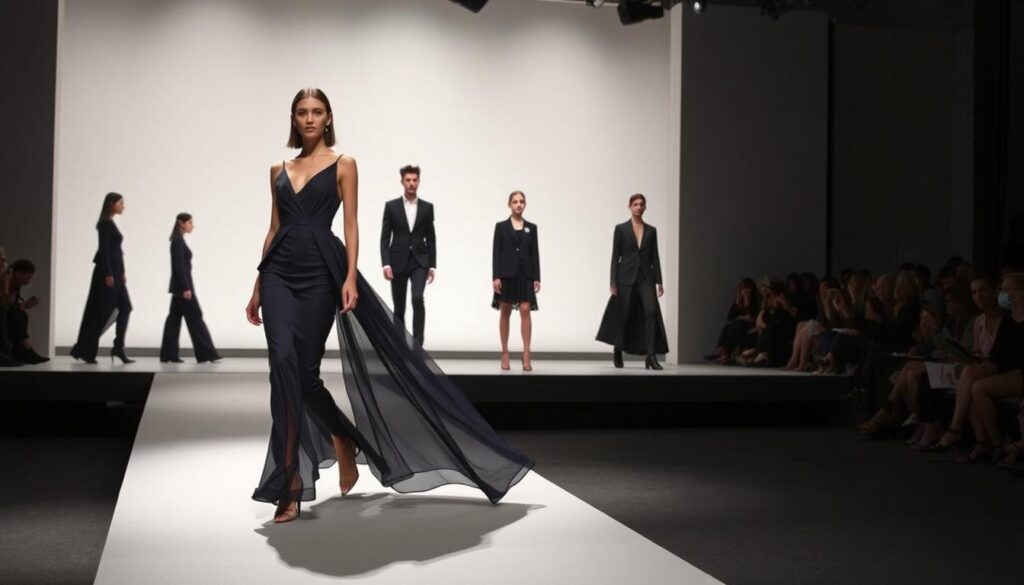
Indigenous Wisdom in Modern Sustainable Practices
Indigenous wisdom about living in harmony with nature is also informing modern sustainable practices in luxury fashion. Ancient knowledge about natural materials, zero-waste approaches, and circular systems is being adapted for contemporary fashion. This not only contributes to a more sustainable fashion industry but also honors the cultural heritage of indigenous communities.
As the sustainable luxury fashion movement continues to evolve, it’s clear that cultural influences are playing a vital role in shaping its future. By embracing global artisanal techniques and indigenous wisdom, luxury brands are creating a more diverse, sustainable, and culturally rich fashion landscape.
Conclusion: Sustainable Luxury as the Future of Fashion
Sustainable luxury is emerging as the new benchmark for excellence in the fashion industry, prioritizing both style and environmental responsibility. As we look towards the future, it’s evident that this shift is not just a trend, but a testament to the power of fashion to drive positive change.
The luxury fashion trends of 2025 are a celebration of innovation, creativity, and consciousness. By embracing eco-friendly practices and materials, luxury brands are setting a new standard that balances style and sustainability. This transformation is inspiring a new generation of consumers who are eager to make a difference through their fashion choices.
We’ve witnessed a multifaceted transformation in luxury fashion, where sustainability has become the defining characteristic of true luxury. The convergence of environmental consciousness, technological innovation, and cultural exchange has created a new paradigm for luxury fashion that prioritizes planetary health alongside aesthetic beauty.
Transparent supply chains, circular design principles, and ethical production methods have become non-negotiable elements of luxury brands’ operations. This shift is fundamentally changing how fashion is created and consumed. Moreover, digital fashion, gender fluidity, and AI-driven design are expanding the creative possibilities of sustainable luxury, proving that environmental responsibility inspires innovation.
As the industry continues to evolve, it is poised to lead the charge towards a more sustainable future, where beauty and responsibility coexist harmoniously. Consumers are driving this transformation through their purchasing power and values, demanding that brands align with their vision for a more equitable and sustainable world.
In conclusion, sustainable luxury will continue to evolve beyond 2025, setting new standards for the entire fashion industry and demonstrating that beautiful, desirable fashion can be a force for positive change in the world. CoWrit Technologies Inc, with its expertise in AI Generative Applications Prompt Engineering, Content Writings, and Digital Marketing, is at the forefront of supporting this transformation. For more information, you can reach out to them at +44-7822010953.
